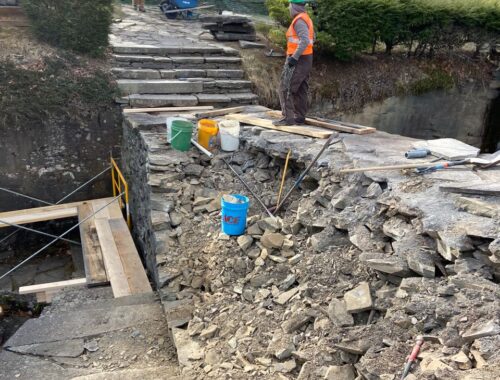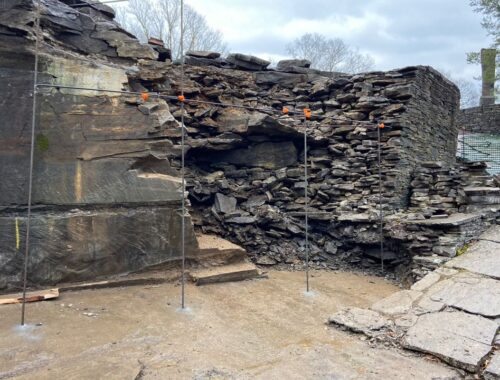
02 Apr Opus 40 Phase 1 Week 1
Restoration Work Underway
The Opus 40 restoration began on Monday March 28, with a crew of 7 wallers for the week. By the end of the week we had exceeded our goals and have a good sense of what we will be doing for this spring’s phase 1 of the restoration work.
Phase 1 includes the tear down and rebuilding of two areas and the establishment of a training wall for workshops and dry stone certification to be run through The Stone Trust. This week focused on stripping out the old stonework that was in poor condition and getting ready to build, as well as getting the foundation set up for the Training Wall.

The Entrance Ramp Wall
The Entrance Ramp Wall
The northeast side of the entrance ramp leading from near the Fite house was in poor shape. Most concerning was the bulging near the bottom of the wall. The top flagstones were dramatically settling which was another sign that all was not well. The southwest side of the ramp had been rebuilt sometime between 2006 and 2012, which both indicated the original construction in this area had come to the end of its life and also that we had the opportunity to repair the other side and the flagging which would result in this vital access point being fully restored.
In disassembly, we found that there was an abundance of stone dust (aka manufactured sand) that had been added under the flagstones at the top in an attempt level them over the past years. This was clearly a more modern addition and was filtering down through the entire wall, further allowing settling as well as trapping moisture which was adding to the damage when it freezes. The northeast wall was stacked as a single skin type wall with loose rubble in behind it. Much of the stone was traced (laid longest face out), and some of the stone was cracking into pieces. The backfill was mostly small stone, and had been dumped in loosely without any apparent attempt to lay it flat to reduce voids. It was easy to see why this area was having issues.
Because the back fill was so loose, once we stripped out the wall, we had to stack a rough face on the back fill to keep it from collapsing while we worked on the new wall. Once that was complete, we set up batter frames to provide a guide in the rebuilding of the wall. At the very end of the week we set a few stones beginning the rebuilding.
The Amphitheater Wall
The Amphitheater Wall
The tall wall was sitting on the flagging from the level below which was being crushed by the weight above. Underneath it all was a bit of rubble and a layer of soil at the very bottom that was undoubtedly a primary contributor to the wall being in a state of near collapse.
The Training Wall
The Training Wall
Building a training wall to run workshops and certifications on was an additional goal of the project. This is being done in a clearing to the northwest of the main sculpture. We installed a gravel pad, and began to bring over stone from a quarry slag pile.




















